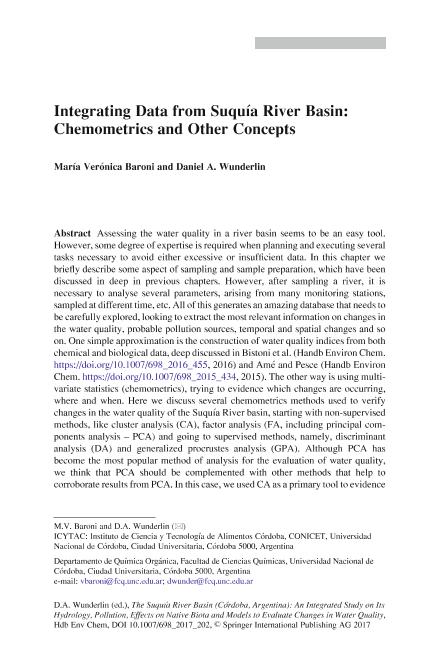Mostrar el registro sencillo del ítem
dc.contributor.author
Baroni, María Verónica

dc.contributor.author
Wunderlin, Daniel Alberto

dc.date.available
2018-06-19T17:57:10Z
dc.date.issued
2017-02
dc.identifier.citation
Baroni, María Verónica; Wunderlin, Daniel Alberto; Integrating data from Suquía River basin: Chemometrics and other concepts; Springer Verlag; Handbook of Environmental Chemistry; 62; 2-2017; 181-202
dc.identifier.issn
1867-979X
dc.identifier.uri
http://hdl.handle.net/11336/49339
dc.description.abstract
Assessing the water quality in a river basin seems to be an easy tool. However, some degree of expertise is required when planning and executing several tasks necessary to avoid either excessive or insufficient data. In this chapter we briefly describe some aspect of sampling and sample preparation, which have been discussed in deep in previous chapters. However, after sampling a river, it is necessary to analyse several parameters, arising from many monitoring stations, sampled at different time, etc. All of this generates an amazing database that needs to be carefully explored, looking to extract the most relevant information on changes in the water quality, probable pollution sources, temporal and spatial changes and so on. One simple approximation is the construction of water quality indices from both chemical and biological data, deep discussed in Bistoni et al. (Handb Environ Chem. https://doi.org/10.1007/698_2016_455, 2016) and Amé and Pesce (Handb Environ Chem. https://doi.org/10.1007/698_2015_434, 2015). The other way is using multivariate statistics (chemometrics), trying to evidence which changes are occurring, where and when. Here we discuss several chemometrics methods used to verify changes in the water quality of the Suquía River basin, starting with non-supervised methods, like cluster analysis (CA), factor analysis (FA, including principal components analysis – PCA) and going to supervised methods, namely, discriminant analysis (DA) and generalized procrustes analysis (GPA). Although PCA has become the most popular method of analysis for the evaluation of water quality, we think that PCA should be complemented with other methods that help to corroborate results from PCA. In this case, we used CA as a primary tool to evidence spatial differences in the water quality along the basin, confirming these results by PCA, which also added evidence on temporal differences. DA allowed further confirmation of both temporal and spatial changes, with an important data reduction, which is important for the survey of a river basin when the budget is restrictive. Finally, GPA brings further confirmation of other chemometrics methods, enabling a clear differentiation between water quality at diverse river sections, during both dry and rainy season. So far, we truly expect that this chapter helps readers to better design future surveys to evaluate changes of the water quality in other rivers worldwide.
dc.format
application/pdf
dc.language.iso
eng
dc.publisher
Springer Verlag
dc.rights
info:eu-repo/semantics/openAccess
dc.rights.uri
https://creativecommons.org/licenses/by-nc-sa/2.5/ar/
dc.subject
Chemometrics
dc.subject
Integrated Evaluation
dc.subject
Multivariate Statistics
dc.subject
River Basin
dc.subject
Water Quality
dc.subject.classification
Otras Ciencias Químicas

dc.subject.classification
Ciencias Químicas

dc.subject.classification
CIENCIAS NATURALES Y EXACTAS

dc.title
Integrating data from Suquía River basin: Chemometrics and other concepts
dc.type
info:eu-repo/semantics/article
dc.type
info:ar-repo/semantics/artículo
dc.type
info:eu-repo/semantics/publishedVersion
dc.date.updated
2018-06-13T14:57:33Z
dc.journal.volume
62
dc.journal.pagination
181-202
dc.journal.pais
Alemania

dc.journal.ciudad
Berlin
dc.description.fil
Fil: Baroni, María Verónica. Consejo Nacional de Investigaciones Científicas y Técnicas. Centro Científico Tecnológico Conicet - Córdoba. Instituto de Ciencia y Tecnología de Alimentos Córdoba. Universidad Nacional de Córdoba. Facultad de Ciencias Químicas. Instituto de Ciencia y Tecnología de Alimentos Córdoba; Argentina
dc.description.fil
Fil: Wunderlin, Daniel Alberto. Consejo Nacional de Investigaciones Científicas y Técnicas. Centro Científico Tecnológico Conicet - Córdoba. Instituto de Ciencia y Tecnología de Alimentos Córdoba. Universidad Nacional de Córdoba. Facultad de Ciencias Químicas. Instituto de Ciencia y Tecnología de Alimentos Córdoba; Argentina
dc.journal.title
Handbook of Environmental Chemistry
dc.relation.alternativeid
info:eu-repo/semantics/altIdentifier/url/http://link.springer.com/10.1007/698_2017_202
dc.relation.alternativeid
info:eu-repo/semantics/altIdentifier/doi/http://dx.doi.org/10.1007/698_2017_202
Archivos asociados
